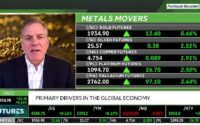As I’m sure you know by now, Henry Kissinger died last week at the age of 100. He leaves a complex legacy, which is certainly understandable because he operated in a complex geopolitical environment.
But Henry Kissinger was a master strategist and political scientist. With his recent passing, I thought I’d retell the story of one of his most brilliant plans, and explain how it relates to the demise of the dollar.
In February 1974, I was asked by Professor Robert W. Tucker of the Johns Hopkins School of Advanced International Studies to join him and four other foreign policy experts for a meeting at the White House.
At the time, confidence in the dollar was on shaky ground because President Nixon had ended gold convertibility of dollars in 1971.
The price of oil was skyrocketing, partly due to inflationary policies pursued by the Federal Reserve, and partly due to an Arab oil embargo in response to U.S. aid to Israel in the Arab-Israeli Yom Kippur War of 1973.
Saudi Arabia was receiving dollars for their oil shipments, but they could no longer convert the dollars to gold at a guaranteed price directly with the U.S. Treasury. The Saudis were secretly dumping dollars and buying gold on the London market. This was putting pressure on the bullion banks receiving the dollar.
Confidence in the dollar began to crack. Anyway, back to my meeting at the White House…
Should We Invade Saudi Arabia?
We were ushered through the security gate on Pennsylvania Avenue near West Executive Avenue, closest to the West Wing. We were then escorted to the office of Dr. Helmut Sonnenfeldt, Secretary of State Henry Kissinger’s deputy on the National Security Council.
There, we engaged in a strategy discussion. Our focus that night was debating a full-scale military invasion of Saudi Arabia.
The idea was we’d then secure their oil fields, pump enough oil to supply Western and Japanese needs and price it however we wanted. We debated the pros and cons of this plan, including potential supply disruptions and international reactions until well into the evening.
Now, it may not be covered in the history books, but a military takeover of Saudi Arabia was very much on the table. In fact, the planning was well underway. But the Nixon administration under Henry Kissinger decided to try one other approach first. And what they came up with was absolute genius.
A few months after my meeting, in June 1974, President Nixon met with King Faisal in Saudi Arabia. A month later, he sent his representatives to offer a new deal. The deal was as straightforward as it was brilliant.
Birth of the Doomsday Deal
The Saudis would agree to sell their oil only for U.S. dollars. These dollars for oil were called “petrodollars.” And the Saudis would then reinvest these petrodollars in U.S. Treasury securities and deposits in U.S. banks.
In return, the U.S. would sell advanced weapons and military hardware to the Saudis and we’d promise U.S. military support to protect Saudi oil fields and the royal family.
This would effectively guarantee the House of Saud long-term rule over the country.
The final twist was that U.S. banks would then “recycle” the petrodollars deposited by Saudi Arabia as loans to emerging markets in Latin America, South Asia and Africa.
In turn, those developing countries would purchase U.S., European and Japanese exports. That would ignite global growth. And, of course, to do that they’d need lots of oil. That meant oil demand would grow endlessly as would demand for dollars. It was the ultimate win-win.
And the 1974 “Petrodollar Accord” was born. Or as I call it, the Doomsday Deal. Behind this “deal” was a not so subtle threat to invade Saudi Arabia and take the oil by force, which I was invited to the White House to consider.
BRICS and the End of the Doomsday Deal
Now, almost 50 years later, the wheels are coming off. The world is losing confidence in the dollar again, and the cracks in the dollar are already getting larger.
It’s important to understand all of this concerning BRICS.
If you’re unfamiliar with BRICS, I’m talking about the economic alliance between Brazil, Russia, India, China and South Africa. I wrote a lot about it this past summer and fall. I explained the changes in the global monetary system that will send shock waves throughout markets.
The BRICS nations represent almost one-third of the entire global GDP. Their economies are bigger than the United States, Germany, Japan, the U.K., France, Canada and Italy combined.
And thanks to Biden’s weakness and foreign policy failures our enemies — and even our allies — are emboldened and the Doomsday Deal is cracked wide open.
The BRICS countries have been running circles around blundering Biden lately.
Blunders
Here’s a quick rundown of some of Biden’s recent failures. On Jan. 17 of this year, shots were fired when Saudi Arabia humiliated Biden and thumbed its nose at America by announcing it is considering accepting other currencies for its oil.
And that announcement opened the floodgates.
On March 8, 2023, Reuters reported another massive blow as India and Russia are now ditching the dollar and trading oil in non-dollar currencies. On March 28, Brazil and China announced an agreement to conduct all future trade transactions using their own currencies.
And it gets even worse. Even our so-called allies saw the writing on the wall.
That same day, French oil giant Total Energies announced they had bought liquefied natural gas from a Chinese oil company using the Chinese currency, the yuan.
Now, other U.S. allies like India, Pakistan and the United Arab Emirates have made deals with Russia or China to buy oil or other commodities in their own currencies.
With Biden in the White House, they’re laughing at us now.
The Beginning of a Seismic Shift
Iraq announced earlier this year they’re now trading their oil for Chinese yuan. Recently it’s only gotten worse…
In August of this year, it was announced Saudi Arabia — our old partner in the Doomsday Deal — will be joining the BRICS group of nations starting in 2024.
And more recently, China and Saudi Arabia agreed to a currency swap deal.
Our enemies were already salivating, and now with this most recent news they are ready to pounce.
In a global political economy long dominated by the petrodollar, this could be the beginning of a seismic shift.
Eventually a tipping point will be reached where the dollar collapse suddenly accelerates as happened to the British pound sterling last century.
My background inside the U.S. intelligence community, investment banks and global currency markets has shown me how smart investors could profit from the failure of the Doomsday Deal.
One of the best ways investors can anticipate this monetary earthquake is by buying gold.


